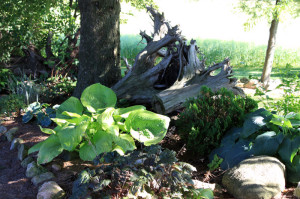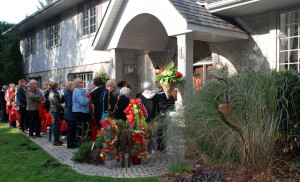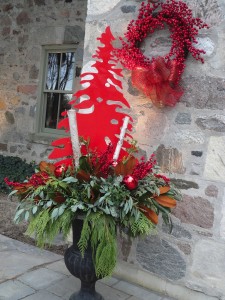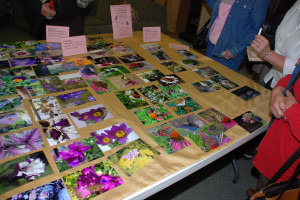It’s Still Just Dirt – The Tillsonburg News, April 23, 2014
by Penny Esseltine
Anxious, eager, excited to get planting? It’s still too soon! But what we can do now is use this time to analyze and amend our garden soil so that our plants will have a better chance of success this year.
Denise Hodgins is a London-based landscape designer and horticultural specialist and when she came to talk to the Tillsonburg Horticultural Society earlier this month she gave us a quick and simple way to figure out the texture of garden soil.
How to analyze your garden soil
Take a large clean mason jar and put a cup and a half of soil from your garden in the jar. Fill the jar with water and “shake the dickens out of it,” Denise says. Sand will start to settle on the bottom in about a minute, Silt will settle above that in anywhere from 45 minutes to two hours and then clay will settle on top of that. Lastly, Denise says there may be some organic matter on top. You can wait until the water clears completely which may be as many as three days to get finer results, but if half of your soil composition is made up of sand you are in good shape.
Sand can be very course, course, medium, fine or very fine and similarly silt can be course, medium, fine or very fine. It’s the top layer of very fine silt that makes clay and too much clay in your garden soil is not a good thing. Denise says the problem with clay is that it dries out in the heat of the summer and makes it hard for plants to grow. “You and I can’t dig in a clay soil garden in July because it’s too hard.”
Luckily, in both of my samples I ended up with one inch of sand, just over a half inch of silt, about one quarter inch of clay and then some sticks and stuff floating on top of the about three and a half inches of water.
However, “If you do have clay soil,” Denise says, “be sure to dig a hole three times wider and three times deeper than the rootball of the plant that you are putting in the garden. Then mix in one bag of top soil and one bag of compost.” This will help to amend your soil and make it good garden soil for your plants to grow in.
What about compost?
Denise says, “you can never, ever, ever put too much compost on your lawns and gardens.” You can make your own compost in bins in the backyard or you can buy bags of compost at garden centres. Businesses that sell bulk garden materials like mulch and gravel or stone will often sell bulk compost too.
To kick start your own compost bins in the spring Denise recommends pouring two kettles of boiling water over the contents. You can also add a layer of shredded newspaper and then a layer of soil on top of that. “Worms love newspaper,” Denise says. This will get them moving through your compost bins.
“Earthworms are our friends,” Denise says. “They like moist soil and lots of organic matter. They make tunnels in the soil that allow plant roots to spread out without a lot of effort.”
Spring lawn care suggestions
With regard to spring lawn care Denise says:
- Don’t rake the thatch out of your lawn. It holds moisture in to feed your lawn throughout the summer.
- Put compost in your fertilizer spreader. Open it up wide and put a light layer of compost on your lawn.
- Add one teaspoon of dish soap to a kettle of boiling water and pour it on large anthills at dusk when the ants have come home for the night. Be careful not to use antibacterial soap because it can also kill good bacteria in the soil. Sunlight soap is good.
Let’s get planting
Denise advises that things will be late this year after our especially cold and abundantly snowy winter. “It will be toward the end of April before plant material arrives in local garden centres, she predicts.” But the end of April is pretty much upon us and with our newfound soil analysis and amendment measures in place, let’s get planting.
There will also be lots of annuals, perennials, shrubs, trees and garden materials for sale at the horticultural society’s 8th Annual Garden Auction on Tuesday, May 20 in the Lions Auditorium at the Tillsonburg Community Centre. Doors open at 5:45 p.m. and the live part of the auction starts at 6:30. All welcome.
For more information about the Tillsonburg Horticultural Society visit our website at tillsonburghorticultural.ca.



